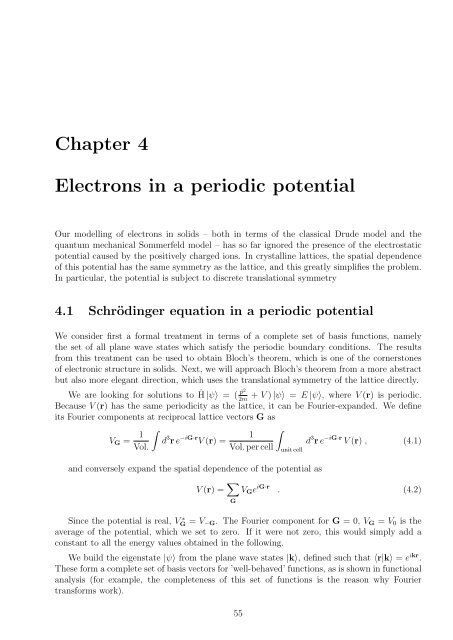Set of supplementary notes.
Set of supplementary notes.
Set of supplementary notes.
Create successful ePaper yourself
Turn your PDF publications into a flip-book with our unique Google optimized e-Paper software.
Chapter 4<br />
Electrons in a periodic potential<br />
Our modelling <strong>of</strong> electrons in solids – both in terms <strong>of</strong> the classical Drude model and the<br />
quantum mechanical Sommerfeld model – has so far ignored the presence <strong>of</strong> the electrostatic<br />
potential caused by the positively charged ions. In crystalline lattices, the spatial dependence<br />
<strong>of</strong> this potential has the same symmetry as the lattice, and this greatly simplifies the problem.<br />
In particular, the potential is subject to discrete translational symmetry<br />
4.1 Schrödinger equation in a periodic potential<br />
We consider first a formal treatment in terms <strong>of</strong> a complete set <strong>of</strong> basis functions, namely<br />
the set <strong>of</strong> all plane wave states which satisfy the periodic boundary conditions. The results<br />
from this treatment can be used to obtain Bloch’s theorem, which is one <strong>of</strong> the cornerstones<br />
<strong>of</strong> electronic structure in solids. Next, we will approach Bloch’s theorem from a more abstract<br />
but also more elegant direction, which uses the translational symmetry <strong>of</strong> the lattice directly.<br />
ˆp2<br />
We are looking for solutions to Ĥ |ψ〉 = ( + V ) |ψ〉 = E |ψ〉, where V (r) is periodic.<br />
2m<br />
Because V (r) has the same periodicity as the lattice, it can be Fourier-expanded. We define<br />
its Fourier components at reciprocal lattice vectors G as<br />
V G = 1 ∫<br />
∫<br />
d 3 r e −iG·r 1<br />
V (r) =<br />
d 3 r e −iG·r V (r) , (4.1)<br />
Vol.<br />
Vol. per cell<br />
unit cell<br />
and conversely expand the spatial dependence <strong>of</strong> the potential as<br />
V (r) = ∑ G<br />
V G e iG·r . (4.2)<br />
Since the potential is real, V ∗ G = V −G. The Fourier component for G = 0, V G = V 0 is the<br />
average <strong>of</strong> the potential, which we set to zero. If it were not zero, this would simply add a<br />
constant to all the energy values obtained in the following.<br />
We build the eigenstate |ψ〉 from the plane wave states |k〉, defined such that 〈r|k〉 = e ikr .<br />
These form a complete set <strong>of</strong> basis vectors for ’well-behaved’ functions, as is shown in functional<br />
analysis (for example, the completeness <strong>of</strong> this set <strong>of</strong> functions is the reason why Fourier<br />
transforms work).<br />
55








